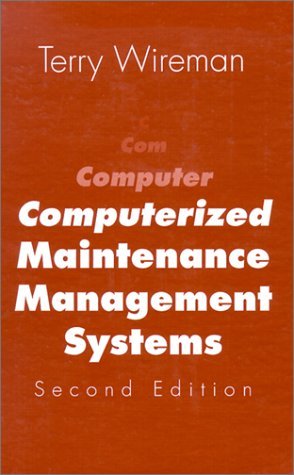comma CMMS equipment maintenance blog
A not-too-deep-dive into Terry Wireman’s "Computerized Maintenance Management Systems" and other recommended reads
Published 2024-04-09 by Alvaro Oberon (a 7.4 minute read) | Back to the main page

Introduction
The transition from paper-and-pen methods to computerized maintenance management systems in manufacturing and utilities, started all the way back in the sixties. Terry Wireman’s “Computerized Maintenance Management Systems” is a pivotal book that has guided many industrial maintenance professionals through this transition. Despite its publication date (way back in 1986), the book’s foundational principles continue to influence current CMMS practices. In most part, it still applies to many cases: brand new implementations, upgrades from digital tools like Excel and Google calendar to a dedicated platform, solution replacements and improvements to an existing system.
In this article we will look at some of the insights the book provides, why is it still a good read (not 1, not 2 but 5 good reasons!) and what other maintenance-related texts are out there that are more modern and worth a read.
Why a good read #1? Understanding the past is just interesting.
Wireman’s book provides a historical context that is important for understanding the evolution of maintenance management. He traces the journey from manual, reactive maintenance to the strategic, proactive approach made much easier by a dedicated maintenance management database. This historical perspective is not only educational but also highlights the significant strides made in the field.
Why a good read #2? The core components of a CMMS are still the same.
The book meticulously details the essential components of a CMMS, including work order management, preventive maintenance scheduling, inventory control, and asset management. Wireman’s thorough explanation of these modules remains as relevant as it did back in 1986.
Why a good read #3? Strategic implementation: a timeless approach.
Wireman offers a strategic framework for CMMS implementation that transcends time. His roadmap for evaluating, selecting, and implementing a CMMS is adaptable to the evolving features of modern systems at least to some extent. The strategic considerations he outlines — such as aligning with organizational goals, ensuring user adoption, and data migration concerns — are still critical to successful CMMS deployment.
Why a good read #4? Cost reduction and cost control: an ongoing goal.
A key theme in Wireman’s ideas, is the potential for cost reduction and enhanced control over maintenance operations through a CMMS. He provides case studies where CMMS has led to significant savings and better decision-making. These objectives remain at the forefront of CMMS benefits today, as organizations continue to seek ways to optimize their maintenance budgets and improve operational efficiency.
Why a good read #5? The strategic value of maintenance
Wireman’s book challenges the perception of maintenance as a mere cost center, positioning it as a strategic function that can contribute to an organization’s success. This perspective has gained even more traction in recent years, with maintenance being recognized as a critical component of asset management and operational excellence.
The book’s limitations
While the book’s core concepts are sound, it does not address the latest technological advancements in CMMS. Modern systems have incorporated real-time analytics, mobile technology, cloud computing, and IoT connectivity. These developments have expanded the capabilities of CMMS beyond what was available at the time of the book’s writing. It still makes it an interesting read in our opinion!
A modern reading list for the maintenance professional
To complement Wireman’s foundational work with up-to-date concepts and technologies, consider the following books (not all only about CMMS implementation, some address general industrial maintenance practices and also written a few years back. This is not at all an exhaustive list (even Terry Wireman has a few more related books), feel free to contribute to more and better titles for this list - contact at the end of the article):
|
|
|
|
|
|
|
|
|
|
Final notes and conclusion
This article aims to provide a general view of Terry Wireman’s "Computerized Maintenance Management Systems", acknowledging its limitations while emphasizing the ongoing relevance of its core concepts. For maintenance professionals looking to deepen their knowledge, exploring both Wireman’s foundational text and the suggested modern resources can offer a comprehensive perspective on CMMS in today’s maintenance landscape.
-----------
Help us get better for the benefit of all in the industry: if you spot any errors and/ or would like to contribute with your knowledge to increase our database of technical articles, please feel free to contact us at info@commacmms.com. We'd love to hear from you.